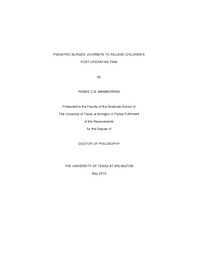
ATTENTION: The works hosted here are being migrated to a new repository that will consolidate resources, improve discoverability, and better show UTA's research impact on the global community. We will update authors as the migration progresses. Please see MavMatrix for more information.
Show simple item record
| dc.contributor.author | Manworren, Renee C.B. | en_US |
| dc.date.accessioned | 2010-07-19T19:54:19Z | |
| dc.date.available | 2010-07-19T19:54:19Z | |
| dc.date.issued | 2010-07-19 | |
| dc.date.submitted | January 2010 | en_US |
| dc.identifier.other | DISS-10407 | en_US |
| dc.identifier.uri | http://hdl.handle.net/10106/4853 | |
| dc.description.abstract | This study sought to bridge the gap of nurses' knowledge of pain management and translation into clinical practice by describing pediatric nurses' negotiation of the bureaucracy of caring. The purpose of this study was to describe factors that influenced pediatric nurses' actions to relieve children's acute post-operative pain on a pediatric post-surgical care unit. The bureaucracy of caring provided the theoretical framework. A qualitative descriptive study of human factors engineering and ethnography was used to quantify the impact of influential variables on time from assessment to intervention. Few knowledge deficits were identified; but nurses' general knowledge and attitudes regarding pain management were not barriers to controlling pediatric patients' post-surgical pains. Patients had good pain control. Results were consistent with the pain management goals of the organization and the nurses' goals that their patients be as comfortable as possible. Unlike previous studies that focused on the amount of analgesics administered to conclude that children were untreated or undertreated for pain, outcome conclusions of this study were drawn from observation of what nurses do in caring for children in pain. Nurses empowered with PRN analgesic orders gave analgesics on a scheduled basis to prevent and treat children's post-surgical pain. Parents influenced pediatric post-operative pain assessment and management. The few patients who had challenging pain experienced pains beyond the patients' and nurses' expectations. These patients had previous experiences with pain from hospitalization and surgery or analgesic side effects. Patients cried, parents' requested analgesics, and/or the patients' pain scores remained of moderate intensity on reassessment despite interventions. Movement and anxiety, as well as, poor communication among the medical staff were contributing factors. These results suggest that individual patients' experiences rather than the organizational culture may influence suboptimal pain management. Yet, nurses waited to notify prescribers of patients' continued pain until prescriber's made patient care rounds. This may reflect the organizational culture, the political dimension, and nurses' failure to effectively negotiate this bureaucracy of caring. To understand factors that contribute to suboptimal pediatric pain management, failure to escalate concerns to prescribers and the hierarchal roles of the political dimension of caring requires further investigation. | en_US |
| dc.description.sponsorship | Cason, Carolyn | en_US |
| dc.language.iso | EN | en_US |
| dc.publisher | Nursing | en_US |
| dc.title | Pediatric nurses' journeys to relieve children's post-operative pain | en_US |
| dc.type | Ph.D. | en_US |
| dc.contributor.committeeChair | Cason, Carolyn | en_US |
| dc.degree.department | Nursing | en_US |
| dc.degree.discipline | Nursing | en_US |
| dc.degree.grantor | University of Texas at Arlington | en_US |
| dc.degree.level | doctoral | en_US |
| dc.degree.name | Ph.D. | en_US |
| dc.identifier.externalLink | https://www.uta.edu/ra/real/editprofile.php?onlyview=1&pid=1421 | |
| dc.identifier.externalLinkDescription | Link to Research Profiles | |
Files in this item
- Name:
- Manworren_uta_2502D_10407.pdf
- Size:
- 1.681Mb
- Format:
- PDF
This item appears in the following Collection(s)
Show simple item record


